Soil Microfauna Surge: Understanding the Phenomenon
In the world of gardening, tiny bugs in plant soil can pose a significant challenge. Here's a guide to identifying, managing, and preventing common types of these soil pests.
### Common Types of Tiny Bugs in Plant Soil
1. **Soil Mites** Soil mites, arachnids not insects, are typically white or light brown, measuring 0.1 – 2 mm. They are slow-moving and primarily live below the soil surface, not climbing onto plants or flying. Generally, soil mites are beneficial and do not need to be removed, as they are an important part of the soil ecosystem. To maintain their presence, ensure well-balanced soil health with proper moisture and nutrient levels.
2. **Springtails** Springtails are small insects that jump rather than walk or crawl. They are often found near water and can be seen on the soil surface. Springtails are generally harmless and do not require removal, but their presence may indicate excessive moisture. To prevent springtail populations from growing, ensure good drainage and avoid overwatering.
3. **Spider Mites (not typically found in soil, but on plants)** Spider mites are tiny, spider-like pests that spin webs on plants. They cause yellow or bronze spots on leaves. To control spider mites, use insecticidal soap or neem oil on infested plants. Regularly inspect plants for early signs of infestation.
### General Prevention Strategies for Soil Pests
- **Maintain Soil Health**: Ensure your soil has good structure and nutrient balance to help reduce the prevalence of unwanted pests. - **Proper Watering**: Avoid overwatering, which can attract pests like springtails. - **Crop Rotation**: Rotate crops to reduce the buildup of soilborne pests and diseases. - **Cleanliness**: Keep gardening tools and surrounding areas clean to prevent the spread of pests.
### Additional Tips
- **Inspect Regularly**: Regularly inspect your plants and soil for signs of pests. - **Use Organic Controls**: Consider using natural pest control methods before resorting to chemicals. - **Education**: Learn about the specific life cycles and behaviors of pests to better manage them. - Using diatomaceous earth, a finely ground powder made from fossilized algae, can lacerate the shells of bugs and dry them out.
In the quest for a pest-free garden, knowledge is power. Understanding these tiny bugs and their habits can help you create a thriving, healthy garden. Happy gardening!
In incorporating indoor plants into your home-and-garden lifestyle, keeping the soil healthy is crucial to deterring small pests like soil mites and springtails. Regular inspections and using organic controls can help manage these nuisances without endangering the beneficial mites or the ecosystem. To maintain the overall garden's health, practice good gardening habits such as crop rotation, proper watering, maintaining soil health, and maintaining cleanliness to prevent soil pests.





